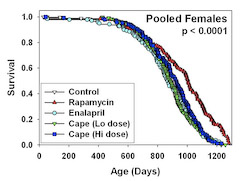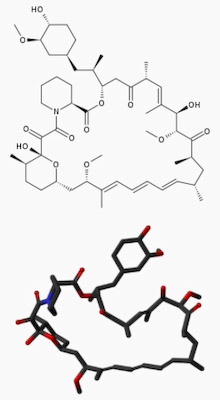Links
Program overview
Research index
Miller Lab home page
Program overview
The National Institute on Aging has begun a multi-institutional program to evaluate agents (mostly drugs or nutriceuticals) on the aging process in mice. The initial goal is to see if any of the tested interventions increase lifespan; follow-up studies will then look for effects on a wider range of age-sensitive traits, postulated mechanisms of aging, and specific diseases. More information about the program can be found here; information about how to propose an intervention for testing can be found here; and a list of agents already accepted for testing can be found here.
Key elements of the program include:
1. Use of genetically heterogeneous mice (stock: UM-HET3), in which each mouse is genetically unique, to reduce the chance that the effects seen (or absence of effects) depend on the idiosyncrasies of any particular inbred or F1 hybrid stock.
2. Simultaneous testing at three sites to see to what extent results depend on specific conditions of housing. In addition to our own colony at the University of Michigan, colonies of ITP mice are managed by Dr. David Harrison (Jackson Laboratory, Bar Harbor, ME) and Randy Strong (University of Texas Health Science Center, San Antonio).
3. Interventions can be suggested by anyone, including academic scientists and those working for commercial organizations. Proposals are evaluated once each year by an Access Committee to select those (3 to 5 each year) for entry into the study. Applicants are asked to provide a rationale for selection of the intervention, any published or unpublished data they think should be considered, and information about safety, toxicity, and physiological effects.
4. The initial ("Phase I") study of an agent has lifespan as the primary endpoint, but also provides some data on age-dependent changes in hormones, T cell subsets, and spontaneous activity. Sufficient numbers of male and female mice are tested so that the study has an 80% chance of detecting an increase (or decrease) in lifespan of about 10%, even if only two of the three sites produce usable data.
For more information about the ITP, you can contact Rich Miller (millerr@umich.edu), David Harrison (deh@jax.org), Randy Strong (strong@uthscsa.edu) , or Nancy Nadon (nadonn@exmur.nia.nih.gov).
Aspirin and NDGA were found to lead to significant lifespan extension in male mice, but not to a significant increase in maximum longevity. There was no lifespan benefit in female mice, presumably because of lower levels of each agent in serum from females. [PubMed]
Rapamycin led to a significant increase in lifespan, including maximum lifespan, in both males and females, with similar results at all three test sites, even though the mice were not placed onto rapamycin-diet until they were already 20 months old. [PubMed]
Rapamycin started at 9 months of age also extended mean and maximal longevity in both sexes at all three sites. The effect of rapamycin at 9 months was not any better than rapamycin started at 20 months. Neither resveratrol (from 12 months, at two doses) nor simvastatin (at either of two doses) produced any lifespan benefit. [PubMed]
Cohort 1 (mice born 2004): aspirin, NDGA (nordihydroguiaretic acid), NFP (nitrofluribprofen), and 4-OH-PBN (4-hydroxy alpha-phenyl-N-tert-butyl nitrone).
Cohort 2 (mice born 2005): enalapril maleate, CAPE (caffeic acid phenethyl ester; two doses), rapamycin (from 20 months)
Cohort 3 (mice born 2006): rapamycin (from 9 months), resveratrol (two doses, from 12 months), simvastatin (two doses)
Cohort 4 (mice born 2007): resveratrol (from 4 months), green tea extract, oxaloacetic acid, curcumin, and median chain triglyceride oil.
Cohort 2009: 17-a-estradiol, methylene blue, acarbose, and three doses of rapamycin
Cohort 2010: fish oil (two doses), and NDGA (three doses)
Cohort 2011: preliminary selection includes spermidine, sulforaphane, metformin, metformin plus rapamycin, and the bile acid UDCA. Final selection will depend on the outcome of pilot studies now in progress.
UM technicians: Maggie Lauderdale, Jessica Sewald, Melissa Han, Bill Kohler, Lisa Burmeister, Lynn Winkleman, Sabrina Friedline.
Collaborators: PIs: David Harrison, Randy Strong. NIA Liaison: Nancy Nadon, Huber Warner
Collaborating scientists: Robert Floyd, Kenneth Hensley, Christiaan Leeuwenburgh, Ennio Ongini, Christy Carter, Krystyna Frenkel, Marco Pahor, Dave Sharp, Clinton Astle, Kevin Flurkey, James Nelson, Martin Javors, Dave Strong, Joe Baur, David Sinclair, Rafael de Cabo, Jim Kirkland, Alan Cash, David Williams, Joseph Starnes, Scott Pletcher, Carlos Orihuela, J. Erby Wilkinson.
Support: NIA U01-AG022303
[last update: December, 2011]

Rapamycin extends lifespan of female HET3 mice

Rapamycin